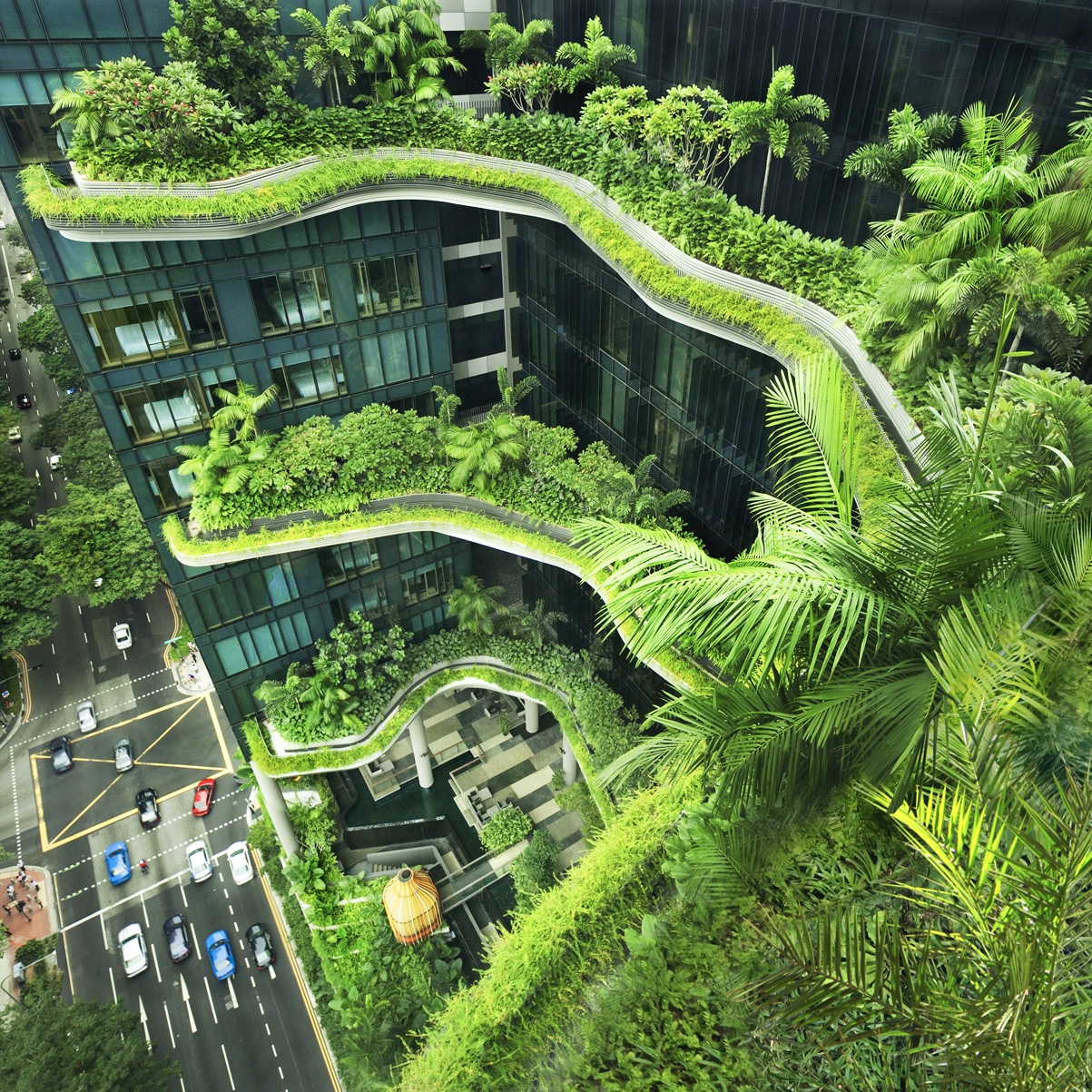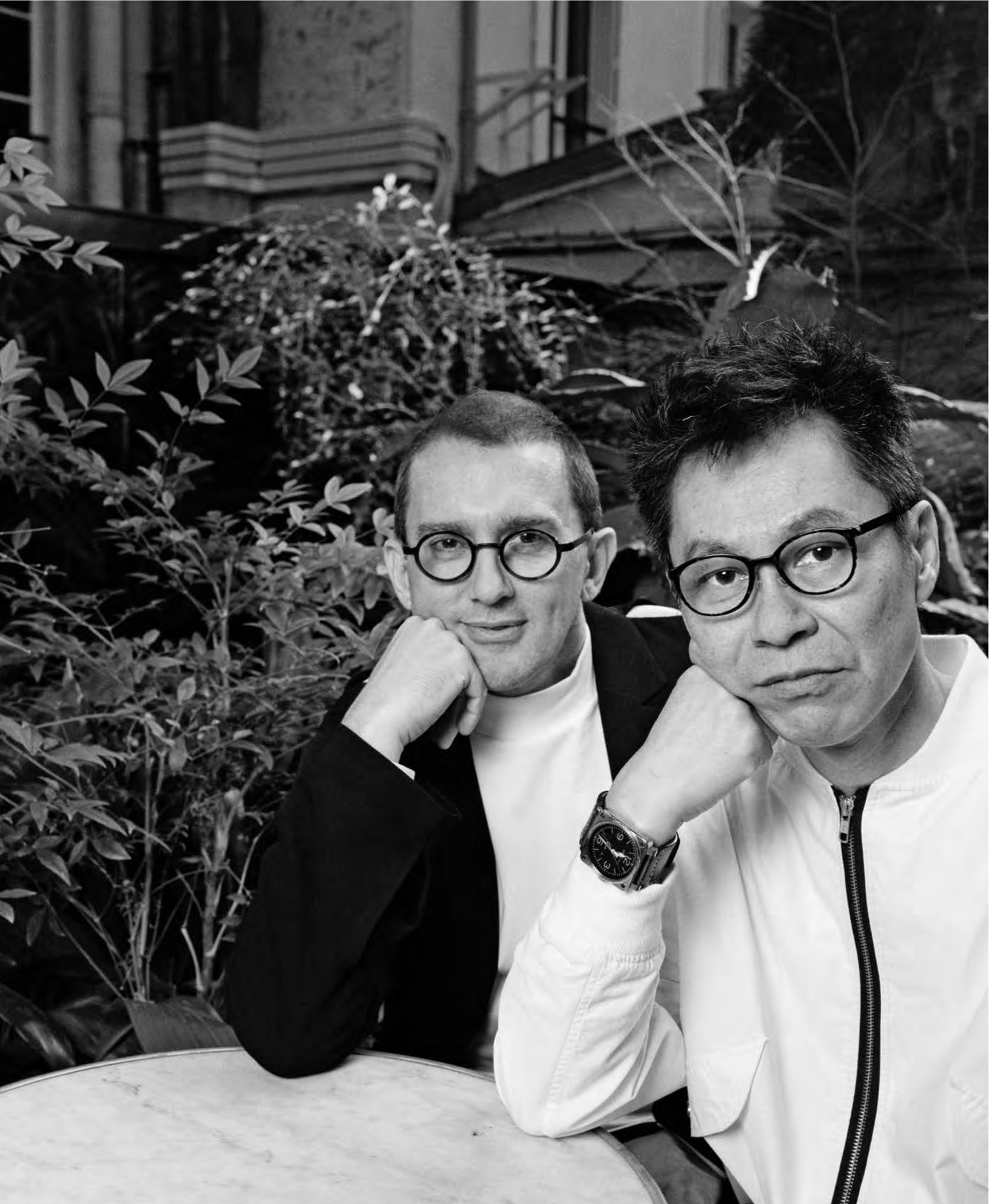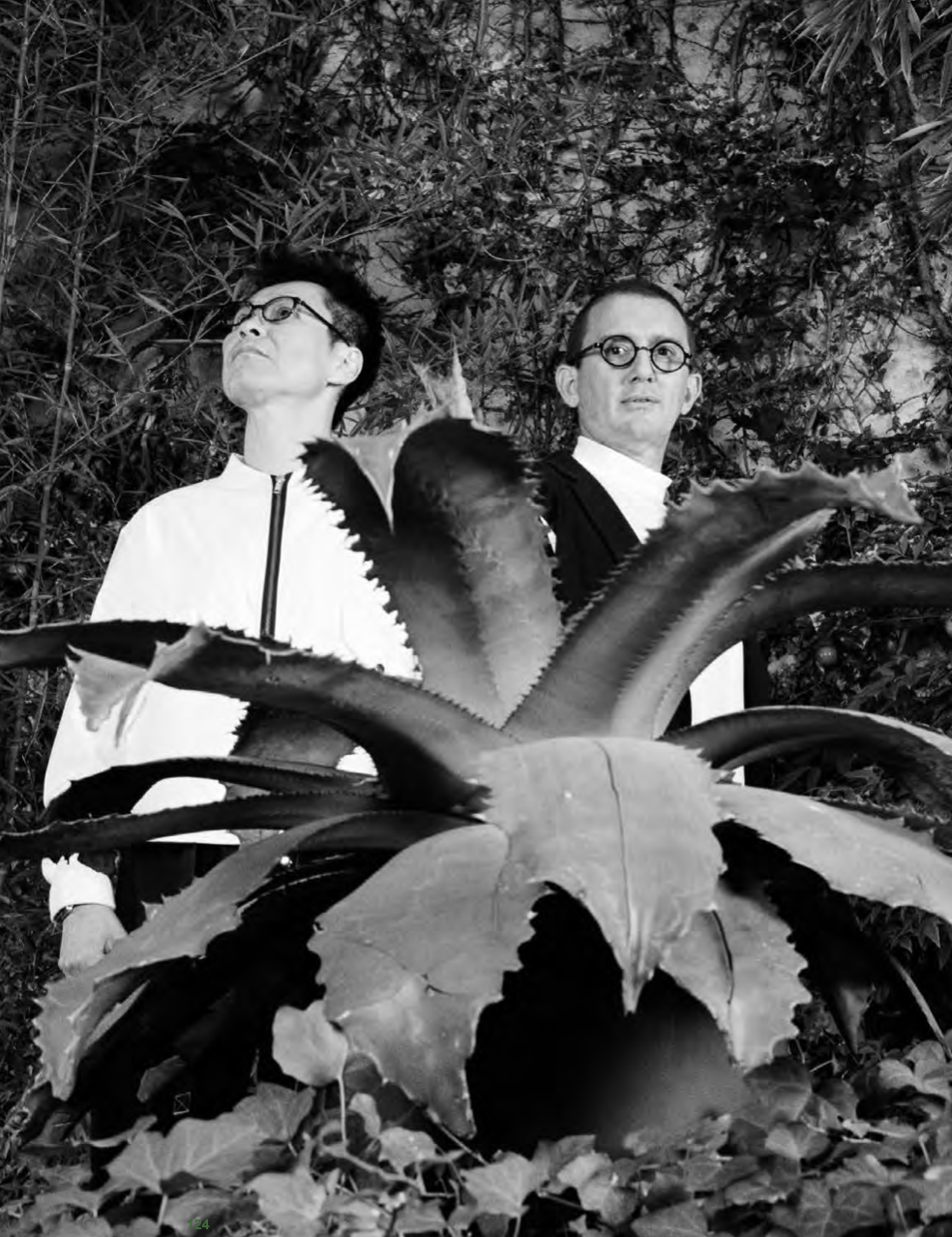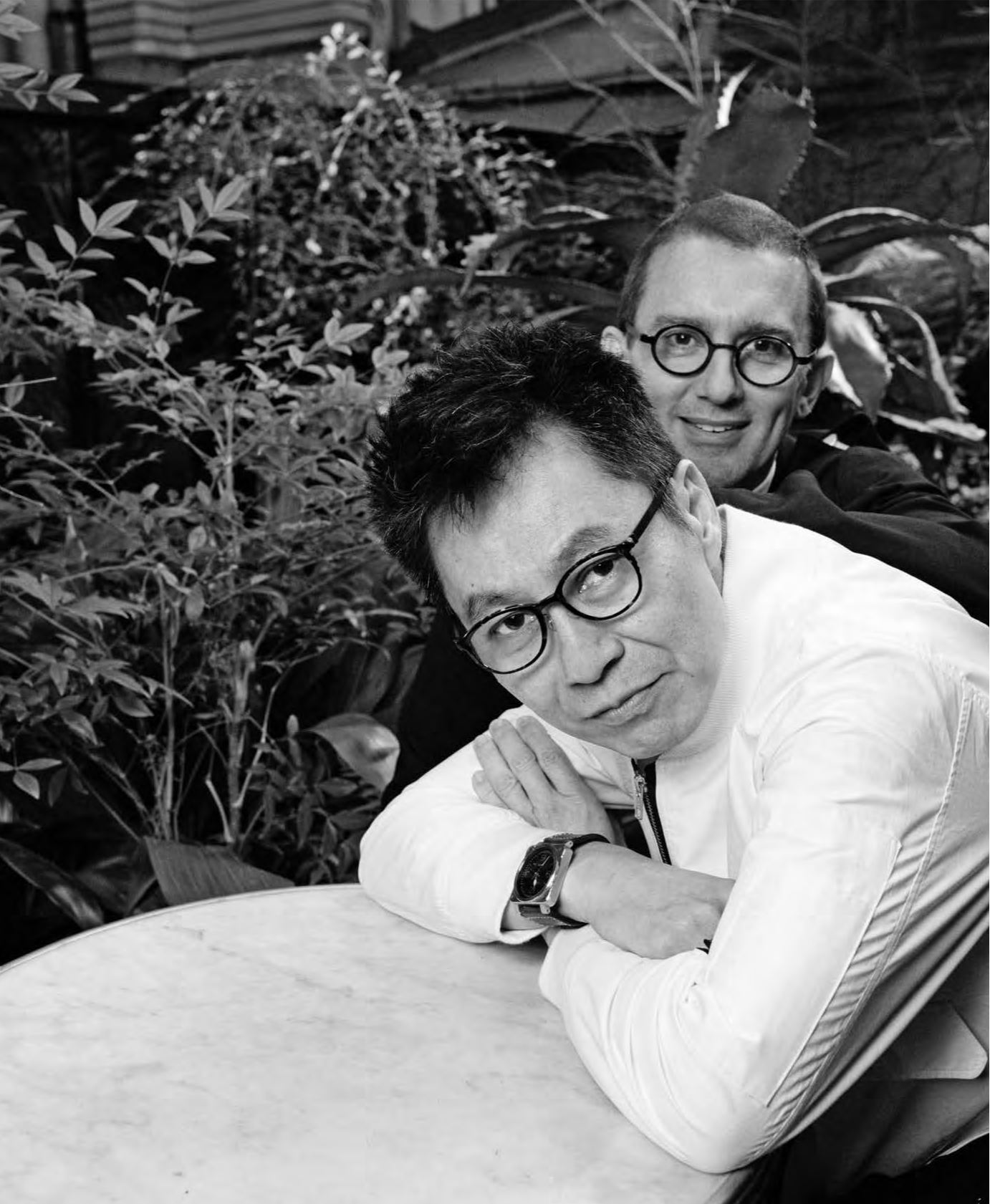WOHA
Interview by Michael Bullock
Portraits by Reto Schmid
PIN-UP 22, 2017

CONCRETE JUNGLES EVERYWHERE ARE ABOUT TO UNDERGO RADICAL GREEN MAKEOVERS. THESE TWO SOFT-SPOKEN ECO-WARRIORS FROM SINGAPORE ARE ALREADY PAVING THE WAY
Founded in 1994 by partners Wong Mun Summ and Richard Hassell, Singapore-based firm WOHA has given green architecture a massive shot of steroids with its daring utopian plans for the future of cities worldwide. Summ and Hassell recently published their ideas in the book Garden City Mega City, Rethinking Cities for the Age of Global Warming, a manifesto for the counterintuitive but convincing case that building greener can only mean building bigger. Establishing a radical new equation that combines sustainability with civic generosity, their win-win philosophy is based in a revival of that 60s utopian dream, the megastructure. Rather than obliterating nature, they say, megastructures allow it to flourish: not only do they consume far less land per inhabitant, they can also become home to “skyparks” and “living façades” — just two of a dozen environmental concepts that WOHA advocate in their book. Such amenities are key in fighting global warming but also in giving back to the community, creating the kind of beautiful shared social space that has typically been exclusive to high-end resorts — a domain the firm knows well, since Summ and Hassell began their architectural careers in the hospitality sector. This proposed shift of goals measures success in terms of self- sufficiency, livability, and the pleasure and lasting enjoyment afforded to users. If this all sounds like poison to developers, think again: what makes WOHA’s position unique is that they have managed to put their ideas into practice. In Singapore alone, the firm has built over 44 projects, not counting the 21 others their staff of 79 is currently working on worldwide. In the past six months, the affable duo has opened two landmark buildings that showcase their innovations. One of them, the four-star Oasia Hotel, has become an instant icon for Singapore’s skyline, a skyscraper that is almost certainly the first in the world to be covered in live flowers. At the other end of the income spectrum is SkyVille@Dawson, an apartment complex commissioned by the Singaporean government to redefine public housing for the 21st century. Now home to 960 families, the 47-story development features an expansive rooftop skypark that has been lovingly nicknamed the “penthouse for the people.” Projects like these, WOHA insist, are proof that the self-sufficient city is ready to be rolled out — it’s the geopolitical mandate that’s missing. After a night at the Oasia, PIN–UP met the crusading duo in their downtown Singapore office to find out about the coming green revolution.

Wong Mun Summ: Hello Michael. What did you think of your experience at Oasia?
Michael Bullock: It was great, thank you! The experience of taking the elevator to the 21st floor and feeling the air flow through the open-air lobby is so radical. And the roof feels almost like an eco-amusement park. I thought it nicely illustrates one of the ideas you talk about in your book: just as a mountain landscape can be seen as rejuvenating and inspiring, so can a megastructure. The building is an instant icon.
Richard Hassell: Oh good! It’s funny, because we tend to design more for the experience, not for the money shot. In fact in some of our projects we can’t even find it. Laughs. But every time I visit the Oasia, I see passersby doing a double take, and then they’ll reach for their phones to take pictures. Nature somehow does that to people; it draws your eyes to it, and you feel very good looking at it. We’re very interested in biophilia, the science of quantifying how humans react to nature and how important it is for things like recovery from illness, or worker productivity. It’s hard data on how nature improves wellbeing.
Well, they should really study the effects on the staff at Oasia — you could tell that they really took pride in working there. What was the initial brief for the building?
WMS: The brief was for a classic skyscraper. But we wanted to put our stamp on it, so we asked ourselves, “What is a tropical skyscraper?” We decided that in a climate like Singapore’s a tall building shouldn’t be made only of steel and glass. Those materials evolved in New York and Chicago, but they’re not necessarily right for here.
I was told that one of the key design features, besides the green façade, was moving the building’s core.
RH: Yes, we moved the core out to the four corners of the building. It’s amazing how limiting the central core and the thin space around it are. Moving the core to the corners allows you to create these open volumes, these atriums that are completely exposed to the city. So you can look up
from the street and say, “Wow, that building has some amazing spaces!”It makes the skyscraper inviting, rather than just another façade that reflects and excludes.
Apart from looking spectacular, is there an economic benefit to having a green façade, or a “living façade” as you call it in your book?
WMS: Shading. Even without the plants, the mesh is a shading device. So first you have physical shading thanks to the mesh, then the plants themselves provide further shade. Plus, the plants reduce the heat because they use sunlight chemically. And they convert the sunlight into food that gives off oxygen at night, and sucks up carbon dioxide during the day. Currently, there are 21 different species of vine on the Oasia’s façade, and 18 species of tree.
RH: I was walking past it last Sunday morning and there were blue morning glory flowers, and Mexican roses...Even though it’s such a big building, it has a sort of delicacy because of the flowers and the mesh. It’s a really sweet building.
Skyscrapers have always been a symbol of hyper-masculinity, and they have typically been enclosed, private spaces built to showcase power. The Oasia building has a different set of values: it’s open and integrated, and it gives back to the ecosystem. Could it be read as an act of queering the skyscraper?
RH: I don’t think that’s an angle developers would
necessarily agree with. But I think it gently subverts the expectations of a skyscraper. Big buildings are normally quite masculine and powerful and this one is pretty and delicate. It’s a very phallic form [laughs], but it’s very feminine at the same time. It’s quite subversive in that way.
MB: You literally covered the symbol of masculinity with flowers.
WMS: [Laughs.] But that’s what innovation is — turning people’s mindset around and rethinking the premise. It’s something that’s necessary in almost every project we do. We start by taking a step back and questioning everything that’s given to us — the site, the brief, and the client’s intentions.
RH: We definitively have a subversive tendency. But in general, the path we’re on with the world’s climate is dangerous, and unless we subvert a whole lot of things, we’re not going to get off of that dangerous path. In a project like SkyVille@Dawson, for example, we can’t emphasize enough how important it is to say that subsidized housing is worthy of tons of thought and care.
One of the things that you talk about again and again is the idea of civic generosity. I’m curious how your sense of social and environmental responsibility developed.
RH: We met when we were both studying in Perth in Western Australia. When we were at university it wasn’t about global warming— the thinking then was that we were going to run out of fuel. So originally our training in environmental design came from that.
WMS: The fuel crisis in the 80s led to the study of interesting low-energy buildings, and because of that there was a resurgence of interest in vernacular architecture. When
we graduated, in 1989, there was a recession in Australia, so Richard came over to Singapore to work here, and we ended up at the same firm together, which specialized in hospitality.
RH: In the 90s, resort architecture didn’t incorporate sustainability yet. It was purely about enjoying beautiful tropical locations — Bali, Malaysia, Sri Lanka... There were some low-energy strategies which tied in with our post-fuel-crisis training — in many ways it was great training to do hotels. If you have 60 rooms in a resort and they all have to sell for 1,000 dollars a night, each room has to be as good as the other. So that was
an important education in egalitarian design.

That’s an interesting parallel, because one of the things I noticed when I visited SkyVille@Dawson was the amount of green space. It felt quite similar to Oasia — it seems you applied your training in luxury resorts directly to government housing projects as well.
RH: Why should those designs be only for the 1,000-dollar-a-night people? Why can’t they be for public housing too? Quality of space doesn’t have to be about the expense of construction and fancy finishes. With SkyVille, we delivered a spatial environment of very high quality made entirely from a prefabricated concrete structure with very utilitarian finishes. It’s about serving people by fighting to create a great environment. You really have to battle for it every step of the way, particularly with public housing, because once they get in the mindset that it’s low-cost they think it means you don’t care anymore. It was really hard actually. People usually go, “This is cheap housing, why are you doing this?”
WMS: But even in our hotels we had to battle the hoteliers. Developers don’t always see fresh air as an amenity and lobbies are usually enclosed. So we’ll be the ones asking, “Why can’t we make the corridors and lobby spaces naturally ventilated and let the user enjoy the environment?” The battle is almost constant.
It seems counterintuitive that your social and environmental ethics were sharpened by creating luxury resorts, but it actually makes a lot of sense. How did you make the jump from resorts to large-scale housing projects like SkyVille@Dawson?
WMS: Up until that point all our work had been outside of Singapore and we had had enough of doing work overseas. We felt we needed to build something here and see it benefiting people on an everyday basis. So that’s when we quit and started WOHA. Of course, when you found your own practice, you start off with small projects, so we began with private houses. But in Singapore only the very rich live in houses. In five years, we became quite well known for doing great houses, and then we had to change direction.
RH: At that point we gave ourselves two years — we funded ourselves to do nothing but large-scale developments and competitions. We were so fortunate that we immediately won the first two competitions we entered. That was in 2000. They were both international competitions for local projects — two underground train stations [The Bras Basah and Stadium Mass Rapid Transport Stations, completed in 2009 and 2010 respectively]. I think the judges were horrified when they found out we had won because it was an enormous competition. You had architects like SOM, Norman Foster, and Zaha Hadid submitting entries. So when they opened the envelope and saw it was us, I think they went, “Oh my god, it’s those luxury-house boys!” [Laughs.]
Were you intimidated making the jump from hotels and private homes to public-transport hubs?
RH: Not really. The hotels we had done were quite large projects, so for us it was a return to a scale we were used to. We’re also very hands-on, and designing different building types doesn’t really intimidate us. People tend to make it a big mystery — “Oh it’s an underground train station with such com- plicated services!” — but it’s not really.
WMS: Of course we don’t work alone. We just needed to ask the right people the right questions and acquire the knowledge, and with time, you know all of it. Our approach was refreshing for the client because we choreographed everything as if we were doing a hotel. But instead of maximizing the view and the sunset, we focused on the enjoyment of the journey and tried to create a place where you actually feel good about being inside a train station.
I didn’t realize that the station was the beginning of the shift in scale for your practice.
WMS: Alila Villas Uluwatu [a five-star resort in Bali] was another important project for our practice. We took that on because we were fed up with all these big-brand hotel operators who equated luxury with consumption. We told ourselves that if we had the opportunity, we would choose to redefine what luxury is. So when we took on that job, we linked the idea of luxury with sustainability. When the project opened, in 2009, that was a fairly new concept for hospitality, so it became the darling of resorts and was hugely successful for the client. Over time all the other brands caught up with it, and now every hospitality brand is singing the same song. So in a way our book, Garden City Mega City, is really a message to city planners, urban designers, and architects, because we realized that alone we can’t create enough to build a better world, but we can help others get on board.
Would you call the book WOHA’s manifesto?
WMS: Yes. In a way. It’s sort of odd that it’s a manifesto because we’re very gentle people.
RH: Well, we’re doing it in a softer way, gentler way. But we want to shift the conversation because we realized — particularly when we gave lectures in the United States — that there is a complete disinterest in the things we thought were important about our projects. We realized that the entire organizational, social, and community strategies were not even registering. It’s as if those aspects were seen as the brief from the client and the architects’ job was just to shape it and make it look beautiful. We think that’s such an abdication of architecture’s responsibility, which is to increase the quality of life of the end-user.
I think the best thing about your manifesto is that it’s backed up with built projects — your solutions have already been tested. Could you explain a few of the key principles, like “high-density and high-amenity?”
RH: Well, when we’re talking about so-called megacities of 60 million people, high densities are a given. The sad thing is that most people have sort of given up, thinking that high density always means overcrowded, noisy cities with immense pressure on public amenities like parks and schools. In everyone’s mind, there is a fixed amount of parks and schools and you just build more and more apartments around them and everyone is competing to use them. We believe that when building a high-rise what you decide to allocate to the space inside it is a political and economic decision — the space doesn’t all have to be sellable or rentable. It’s completely possible to use it for parks and schools and churches or whatever you consider is a requirement for your community. You can actually make these developments very generous as long as you have the will, or the budget, or the regulations in your favor. SkyVille, for example, is a demonstration that you can live in a quite spacious garden environment despite being in a 47-story building.
So you’re turning increased urban density, which is typically viewed as a negative, into an opportunity to deliver more amenities?
RH: Well, if you didn’t have the population pressure you would never do it, because obviously it costs money to put a park on the roof. But if you’re looking at urban sprawl, and the city becoming twice as big, and the cost of all that infrastructure and the energy used in all that transport and putting in all those sewer and pumping stations and so on, then the cost of putting the park on top of the buildings versus having to double the size of the city is much lower. And it makes a lot of sense because it’s really close to where the residents live.
WMS: City planners and urban designers aren’t usually innovating new ideas, they’re only crunching numbers. Skyville@Dawson is actually a very scalable project, but as you scale further up, you could start placing infrastructure on sky streets: schools, daycare centers, food courts, and other amenities that are typically located at ground level. Planners currently think of the city in two-dimensions and put all the infrastructure on the ground floor, but high-density cities need to view themselves in three dimensions.
Is that what you mean when you refer to “multiple ground levels?”
WMS: Yes. We wanted to use the word “ground” because that’s where infrastructure typically happens. But we believe it could be multiplied on many levels, not only on the ground level.
The second half of your book introduces a new environmental rating system. Is it like the LEED system?
WMS: No. We actually got fed up with the LEED system. You can design a bad building and it will still earn the LEED platinum certification. So we think the LEED is fundamentally flawed.
RH: LEED tracks progress and state-of-the-art materials and technologies. For example, you could be LEED platinum, but only be 20 percent self-sufficient. So our system measures how materials and technologies are used to create sustainability. If we want to be self-sufficient then basically every- thing we build has to pull its own weight. Our self-sufficiency index sets that as the end game. It introduces a sense of urgency. Then we have to keep working because we don’t have many project cycles to solve that problem.
Was the self-sufficiency index primarily created to help you judge your own success?
RH: Yes. The rating system is good for cities in general because before this there was no way to really define what makes a livable city.
My favorite measurement is the green-plot ratio. Can you explain it?
WMS: That one is quite obvious. It’s how much placement of green there is. The PARKROYAL on Pickering Hotel [2013], for example, has a green-plot ratio that is 250 percent higher than its original site. And the Oasia Hotel’s green-plot ratio is 1,100 percent higher. It more than satisfies its own footprint, so if another building doesn’t do it, we’re generous enough to do it for ten other sites. [Laughs.]

The PARKROYAL on Pickering faces a park. Was your goal to match the green space with your building?
WMS: Yes. A wealthy philanthropist in the 19th century donated money to convert that area of the city into a park for workers. We didn’t tell the client at first, but we wanted to create a civic generosity in this building by replicating an entire piece of park as gardens in the building.
RH: Once you get used to the idea that you have planting on buildings you can develop it even further so it actually helps support biodiversity. The plants are not only there because they’re pretty to look at and provide shade — they can actually be a habitat for our fellow inhabitants of the world, for animals.
I heard there’s even a parrot that lives in the PARKROYAL façade.
RH: Yes. And we’ve seen birds fly from one of our sky gardens to the other, across from one building to another. Those are the moments when you realize that you’re also designing buildings as ecosystems, which means food sources, nesting places, habitats. Although at the moment only birds can get to them.
WMS: Actually the Oasia is also for climbing creatures like squirrels. They can climb from one level to another and visit all the sky gardens. We’ve seen how much people are delighted by animals — and animals can look at humans too! It’s added value. [Laughs.]
You wrote that you believe buildings should be judged by human characteristics — Are they friendly? Are they generous? Are they accommodating? I never thought of buildings like that.
RH: Well, every building should be about community rather than just profit. Because the end game of profit is usually, “I’m trying to grab as much stuff for myself so that I have more than anyone else.” It’s all about taking and not giving anything. It’s the same reason people don’t like paying taxes, because they feel like the public realm is a big drain. But we think it’s not — when people work together and collaborate, everybody benefits. Cities should reflect that ethos, rather than putting up walls and shoving people off. It’s about being the equivalent of a good citizen for a building: the building is a good citizen of the city if it’s welcoming, sheltering, and sharing. And that’s ultimately what makes a nicer city.


